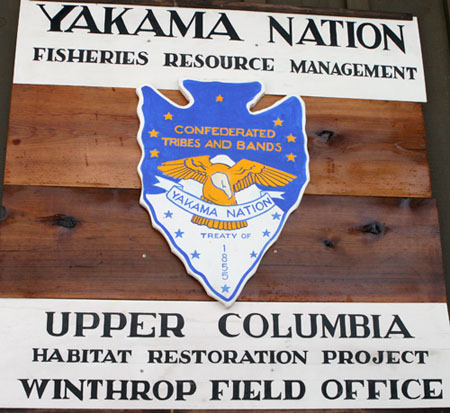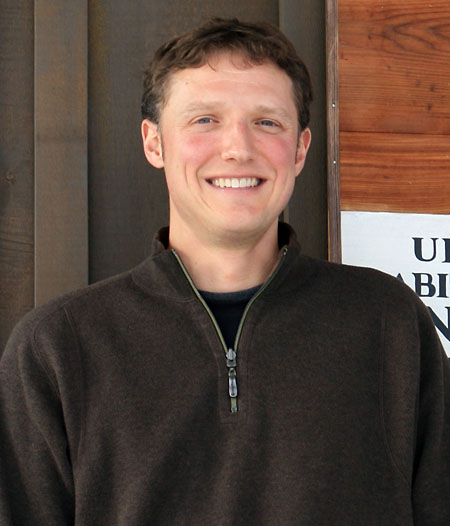home | internet service | web design | business directory | bulletin board | advertise | events calendar | contact | weather | cams

|
In Support of Fish  The Yakama Nation is receiving funding from the Bonneville Power Administration to try to restore fish habitat. The tribe recently opened an office in Winthrop. The Yakama Nation is receiving funding from the Bonneville Power Administration to try to restore fish habitat. The tribe recently opened an office in Winthrop.Two endangered species struggle against high odds for survival in the clear-flowing waters of the Methow Valley watershed: spring Chinook and steelhead. The Yakama Nation, headquartered many miles away near Toppenish, recently established an outpost in Winthrop, in the building behind Methow Cycle and Sport, where biologists are painstakingly trying to improve those odds for wild fish. The Yakama come by their interest in the Methow’s fish runs thanks to their historic reliance on fish that swam up the main stem of the Columbia River to spawn in the tributaries of the Upper Columbia system. The Yakama don’t fish here; they take homeward-bound salmon and steelhead spawned in the Methow from the Columbia main stem. The fish habitat restoration work in the Methow falls under the wide umbrella of the so-called Biological Opinion, the federal Northwest salmon recovery template administered under the jurisdiction of U.S. District Court Judge James A. Redden in Portland. And since the 1974 Boldt decision, the state’s fishing tribes have been co-managers with the State of Washington’s salmon fisheries. The federal hydroelectric dams many decades ago all but destroyed the famed fishery that the Yakama depended on. But it wasn’t until 2008 that the Bonneville Power Administration signed an agreement with the tribe to provide $6 million a year for 10 years to try to restore river habitat in the Methow, Wenatchee and Entiat sub-basins of the Columbia. “We don’t have to ask for funding,” says Hans Smith, one of two habitat biologists working for the Yakama Nation’s Upper Columbia Habitat Restoration Program in Winthrop. Yet four years into that effort, says Smith, scientists have yet to spend all the annual allotment of funds from BPA’s ratepayers. Restoring wild fish requires more than just throwing money at them. You have to understand the hydrological and ecological secrets of creeks and rivers. And you have to get people on board, he explains. “We can’t force anyone to do reconstruction” of river habitat, says Smith. Landowners along the rivers and creeks volunteer to cooperate with the habitat restoration effort or it doesn’t get done. The tribe prefers to simply assist landowners with restoration measures, says Smith. But it also can enter into easement agreements or buy lands outright. The tribe has signed four easements administered by the Methow Conservancy and has purchased four riverbank parcels. These easement and land purchases are on Beaver Creek, the Chewuch River, Twisp River and along the Methow River near Mazama, says Smith. If the landowner sells, the title is conveyed to the Methow Salmon Recovery Foundation because the tribe does not want to own and maintain land so far away from its reservation, according to Smith. Once habitat restoration is completed, the land may be re-sold with the habitat restrictions dictated by the tribe legally attached to the tile.  Hans Smith is one of two habitat biologists working at the new Winthrop office. His work is focused on improving juvenile habitat for endangered wild fish. Hans Smith is one of two habitat biologists working at the new Winthrop office. His work is focused on improving juvenile habitat for endangered wild fish.A seventh-generation Seattleite whose ancestors settled – and fished for salmon - at Alki, Smith, 34, has been working for the tribe since 2009. A graduate of the University of Washington’s College of Forestry, he’s on the Twisp City Council and first came to the Methow as an intern with the Pacific Biodiversity Institute. Not only the tribe but state and federal agencies are engaged in various salmon recovery projects in the Methow watershed. The Washington Department of Fish and Wildlife, the U.S Bureau of Reclamation, the U.S. Geological Survey and the Upper Columbia Salmon Recovery Board - the latter chaired by Okanogan County Commissioner Bud Hover - all have had a role to play. And as part of the fish run restoration efforts, local hatcheries produce what sometimes are derided as “man-made” fish. But Smith’s work is focused on improving juvenile habitat for endangered wild fish native to the valley’s rivers. Scientists have learned that if the wild spring Chinook, also known as king salmon for their great size, are to have a chance to recover in the Methow, one of the most important things that must be done for them is to improve the habitat they’re in for the first year of their lives here before they set off to sea, says Smith. (Spring Chinook are to not be confused with summer Chinook, which are not listed as endangered and are genetically different; juveniles don’t over-winter here. Adult spring Chinook cross the Columbia Bar in March, reach the Methow in June, and spawn in late August and early September, while summer Chinook spawn in early to mid-October.) The challenge, as Smith describes it, is to grow juvenile spring Chinook that are robust enough for the journey to Alaska and back when they leave here. “A lot of the fish leaving this valley are too small,” says Smith. Not quite six inches long, they’re not trucked or barged around the dams; they have to get to the mouth of the Columbia on their own. But to thrive and grow to optimum size and strength in the Methow, they need many improvements in their local living arrangements. Over time their habitat in the valley has been altered by armoring of its rivers with rip-rap - ill-considered, often ill-fated efforts to prevent erosion - loss of overhanging or streamside vegetation, and inefficient irrigation. According to Smith remedies are planting trees and bushes, adding woody debris along riverbanks, and helping irrigators find more efficient means to use water. “We’re not trying to close down agriculture,” stresses Smith. Hydrologists and engineers from Oregon-based Inter-Fluve Inc., experts in river restoration under contract to the tribe, have taken the measure of the valley’s rivers and creeks in an effort to understand where the most promising rehabilitation places exist, says Smith. Much of the most potentially productive fish rearing waterscape lies between Mazama and Winthrop along the Big Valley Ranch, he says. Aquifer upwellings there help moderate water temperatures for juveniles in winter, and water is available year-round, he explains. The tribe is working to improve habitat along an eight-mile long stretch of the Twisp River from Newby Creek to Twisp city park, as well as along the Methow River from the smoke jumper base to the Twisp city park. Below Carlton, the geology and lack of vegetation and suitable hiding places make it an unlikely place for intervention, Smith adds. “We can restore habitat until we’re blue in the face and the dams may still offset recovery,” Smith acknowledges. And, he adds, “Currently there’s no detectable increase in this particular stock.” But it’s too early to tell what will happen. Spring Chinook typically are at sea for three to four years, and the four-year-old Methow habitat restoration project has six years to go. 01/18/12 find past postings in the archive >> Comments Well written article! Laura Stanley Seattle This is very important work that is being done. I applaud Mr. Smith and his colleagues in their laudable efforts to restore salmon habitat. Thank you. S. Stanley Seattle What a "hans"-some article. Sarah Schrock Twisp Very important and informative article. I did not know about Spring Chinook. Mr. Smith thank you for your dedication to our environment and restoration of this important habitat. Ann Ralston Seattle Can any of the funds be used to provide scholarships to Yakima nation members for education in resource management? A great opportunity for Yakima members! Gay Northrup Mazama Thanks for the great article Solveig! And congratulations Hans for the recognition for all the great work you are doing to restore salmonids to the Methow! Peter Morrison Winthrop
|